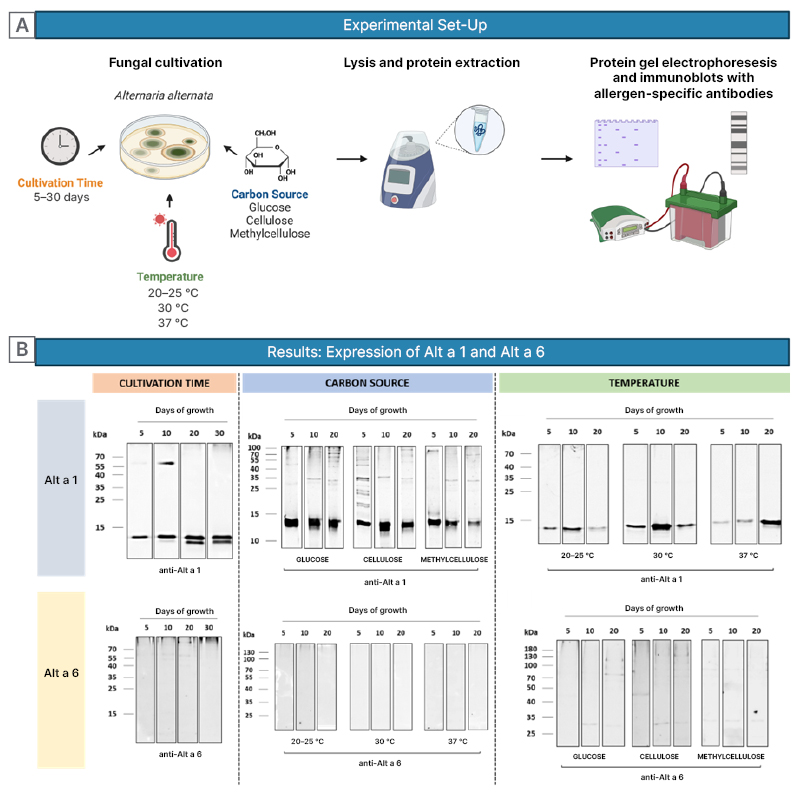BACKGROUND AND AIMS
Alternaria alternata is one of the most potent sources of airborne allergens.1,2 However, the diagnosis of A. alternata sensitisation is hampered by the poor quality of allergy test solutions.3 Cultivation conditions can have a major impact on the allergens present in mould extracts.3-5 The majority of previous studies have mainly focused on the effect of growth parameters on the expression of single allergens, without analysing the occurrence of other allergens.6,7 Multiple A. alternata allergens have already been identified and characterised.1,8 Two molecules, the major allergen Alt a 1 (15 kDa) and the cross-reactive allergen Alt a 6 (47 kDa), are the species’ most relevant allergens.1,8 The aim of this study was to investigate the impact of different cultivation conditions on the expression of these two allergens.
MATERIALS AND METHODS
To analyse the effect of environmental conditions on fungal allergen expression (Figure 1A), clones of A. alternata were cultivated in the presence of different carbon sources (i.e., glucose, cellulose, and methylcellulose), or at different temperatures (i.e., 20–25 °C, 30 °C, 37 °C). Then, protein extracts were prepared from the fungal material (mycelium and spores), which were harvested after different days of growth. To detect the expression of the allergens Alt a 1 and Alt a 6, Western blots with allergen-specific antibodies were carried out.
RESULTS
Western blots performed with antibodies directed against Alt a 1 and Alt a 6 showed that the expression of the fungal allergens is highly molecule-dependent. The carbon source, cultivation temperature, and growth time did not have a major impact on the expression of Alt a 1, as fungal allergen extracts containing the allergen could be easily produced from fungi grown under various conditions (Figure 1B). For example, Alt a 1 could still be extracted from very small amounts of fungal biomass that was harvested after 5–20 days of growth at 37 °C. Moreover, results of anti-recombinant Alt a 1 immunoblots revealed that the growth on glucose, an easily accessible substrate, compared with the growth on more complex carbon sources (i.e., cellulose, methylcellulose), did not have a major impact on the expression of Alt a 1. In contrast, Alt a 6 could not be detected in protein extracts prepared from A. alternata grown under any condition (Figure 1B). These results demonstrate the difficulty in producing reliable allergen extracts containing fungal enolase.

Figure 1: Analysis of the impact of different cultivation conditions on the expression of Alternaria
alternata allergens.
A) Experimental set-up for the analysis of the impact of different cultivation conditions on the expression of the Alternaria alternata allergens Alt a 1 and Alt a 6. B) Expression of Alt a 1 and Alt a 6 in A. alternata grown under different conditions (cultivation time, carbon source, temperature), shown by anti-Alt a 1 and anti-Alt a 6 immunoblots.
rAlt a 1: recombinant Alt a 1; rAlt a 6: recombinant Alt a 6.
CONCLUSION
Taking A. alternata as an example, the authors’ data reveal that even though certain cultivation conditions might lead to strong expression of one allergen, the same conditions might not be optimal for the expression of another allergen. This emphasises the necessity of determining the optimal cultivation and extraction conditions for each allergen separately. Information obtained in this study will help to optimise fungal cultivation to produce highly potent diagnostic fungal extracts, and therefore to improve allergy diagnosis. In the future, it will be of interest to also investigate the effect of further cultivation conditions on the expression of A. alternata allergens, to include additional allergens in investigations and, of course, to extend the analyses to further fungal species.






